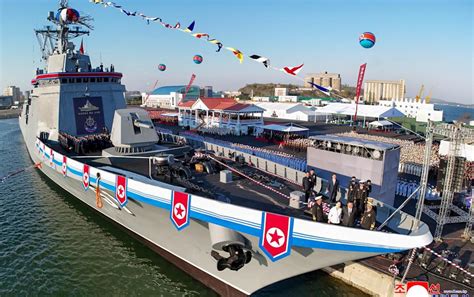
Kim Jong-un reportedly witnessed the failed launch of a new North Korean warship, an event that has triggered his intense displeasure and a subsequent investigation into the causes of the mishap.
North Korean leader Kim Jong-un’s ambition to bolster the nation’s naval power suffered a significant setback recently, as the inaugural launch of a new warship ended in failure. According to reports, Kim personally oversaw the event, and the unsuccessful launch has resulted in considerable fury, prompting a thorough investigation to determine the cause of the debacle. The incident highlights the ongoing challenges facing North Korea’s efforts to modernize its military capabilities amid international sanctions and technological hurdles.
The launch, intended to showcase North Korea’s advancements in naval technology, instead became a source of embarrassment and frustration for the regime. While details of the specific type of warship and the exact nature of the failure remain scarce, the repercussions are evident in the reported anger of Kim Jong-un and the subsequent inquiry launched to identify those responsible and rectify the issues. The incident raises questions about the reliability of North Korea’s military hardware and the competence of its engineering and technical personnel.
The failure underscores the difficulties North Korea faces in its pursuit of military modernization, particularly in the face of stringent international sanctions that limit access to advanced technology and resources. Despite these obstacles, Kim Jong-un has consistently prioritized the development of the country’s armed forces, viewing it as essential for national security and regional influence. This recent setback, however, serves as a reminder of the inherent risks and challenges involved in such endeavors.
The event also highlights the internal dynamics within the North Korean leadership. Kim’s reported anger suggests a zero-tolerance policy for failure, which can create a high-pressure environment for officials and engineers tasked with carrying out his directives. The investigation into the failed launch is likely to involve a rigorous assessment of the technical aspects of the project, as well as an examination of the performance and accountability of those involved.
The implications of this failed launch extend beyond mere technical setbacks. It could potentially impact North Korea’s strategic calculations and its approach to military development. The incident may prompt a reassessment of priorities, a renewed focus on quality control, and a greater emphasis on addressing the underlying technological and logistical challenges that hinder the country’s military modernization efforts.
Details surrounding the launch remain shrouded in secrecy, typical of North Korea’s state-controlled media environment. Outside observers rely on intelligence reports, satellite imagery, and information gleaned from defectors to piece together a more comprehensive picture of the country’s military activities. As such, the full extent of the warship launch failure may not be immediately apparent, but the available information suggests a significant setback for Kim Jong-un’s naval ambitions.
This incident occurs against the backdrop of heightened tensions in the Korean Peninsula, with ongoing concerns about North Korea’s nuclear weapons program and ballistic missile tests. The country’s military activities are closely monitored by regional powers and international organizations, who are wary of the potential for escalation and instability. The failed warship launch adds another layer of complexity to the already intricate geopolitical landscape.
The drive to develop a modern and capable navy is a key component of Kim Jong-un’s broader military strategy. North Korea has invested heavily in the construction of new warships, submarines, and other naval assets, aiming to project power and protect its maritime interests. The recent setback, however, raises questions about the effectiveness of these investments and the overall progress of the country’s naval modernization program.
Experts suggest that North Korea faces numerous challenges in its pursuit of naval power, including outdated technology, limited access to advanced materials, and a shortage of skilled personnel. The country’s shipbuilding industry also suffers from inefficiencies and quality control issues, which can lead to defects and malfunctions in its vessels. The failed warship launch may be indicative of these underlying problems, highlighting the need for significant improvements in the country’s shipbuilding capabilities.
The reaction from the international community to the failed launch is likely to be muted, given the existing concerns about North Korea’s nuclear program and other provocative actions. However, the incident may serve as a reminder of the limitations of North Korea’s military capabilities and the challenges it faces in achieving its strategic objectives. It could also prompt renewed calls for dialogue and diplomacy to address the underlying tensions in the Korean Peninsula.
Looking ahead, it remains to be seen how North Korea will respond to this setback. Kim Jong-un may choose to double down on his efforts to modernize the military, perhaps by allocating more resources to naval development or seeking assistance from foreign partners. Alternatively, he may decide to scale back his ambitions, focusing instead on addressing the country’s economic challenges and improving living standards. The path he chooses will have significant implications for the future of North Korea and the security of the region.
While concrete evidence regarding the specific type of warship and the precise cause of the failure remains limited, the incident underscores the inherent risks and challenges associated with North Korea’s military modernization efforts. Further investigation and analysis will be needed to fully understand the scope and implications of this setback.
The implications of this event could extend beyond North Korea’s immediate military capabilities. Domestically, the failure may impact morale within the armed forces and the broader population, potentially undermining Kim Jong-un’s image as a strong and capable leader. Externally, the incident could affect North Korea’s relations with other countries, particularly those involved in monitoring and responding to its military activities.
The incident also highlights the importance of accurate intelligence and analysis in assessing North Korea’s military capabilities. The international community relies on a variety of sources, including satellite imagery, open-source information, and human intelligence, to track developments in North Korea and understand its strategic intentions. The failed warship launch underscores the need for continued vigilance and a comprehensive approach to monitoring North Korea’s military activities.
The incident raises questions about the future of North Korea’s naval modernization program. Will the country be able to overcome the technical and logistical challenges it faces? Will it be able to acquire the advanced technology and resources it needs to build a modern and capable navy? The answers to these questions will have significant implications for the balance of power in the region and the security of the Korean Peninsula.
The failure of the warship launch serves as a cautionary tale, reminding us of the complexities and uncertainties involved in military modernization efforts. It also underscores the importance of sound planning, effective management, and rigorous quality control in ensuring the success of such endeavors. As North Korea continues to pursue its military ambitions, it will need to address these challenges if it hopes to achieve its strategic objectives.
The situation also highlights the pervasive information control within North Korea. Independent verification of the events surrounding the failed launch is extremely difficult, and the information available is often filtered through state-controlled media outlets. This makes it challenging to assess the true extent of the damage and the impact on the North Korean regime.
Nevertheless, the news of Kim Jong-un’s reported fury suggests that the failure is being taken seriously at the highest levels of the North Korean government. The subsequent investigation could lead to significant changes in personnel, priorities, and strategies related to the country’s naval modernization program.
Moreover, this incident may have a ripple effect on other areas of North Korea’s military development. The emphasis on naval power is part of a broader effort to enhance the country’s overall military capabilities, including its nuclear and missile programs. A setback in one area could potentially impact progress in others.
The international community will be closely watching how North Korea responds to this challenge. Will the country become more isolated and confrontational, or will it seek to engage in dialogue and cooperation? The answer to this question will depend in part on the internal dynamics within North Korea, as well as the policies and actions of other countries in the region.
Ultimately, the failed warship launch is a reminder of the inherent limitations of North Korea’s capabilities and the challenges it faces in achieving its strategic goals. While the country has made significant strides in its military development over the years, it still lags behind many other nations in terms of technology, resources, and expertise.
The geopolitical context surrounding the Korean Peninsula remains complex and volatile. The presence of multiple actors with competing interests creates a high-stakes environment in which even seemingly minor incidents can have significant consequences. The failed warship launch adds another layer of uncertainty to this already intricate situation.
It’s important to note that North Korea’s military modernization efforts are driven by a complex set of factors, including national security concerns, regime survival, and regional influence. Understanding these motivations is essential for developing effective strategies to address the challenges posed by North Korea’s military activities.
The international sanctions imposed on North Korea have had a significant impact on its economy and its ability to acquire advanced technology. While these sanctions have not completely halted North Korea’s military development, they have undoubtedly slowed it down and made it more difficult.
The incident also raises questions about the role of foreign assistance in North Korea’s military programs. While North Korea is largely self-reliant in its military development, there have been reports of foreign entities providing assistance, particularly in the area of technology transfer.
The failed warship launch underscores the importance of international cooperation in addressing the challenges posed by North Korea’s military activities. No single country can effectively address these challenges alone. A coordinated approach involving multiple actors is essential.
The situation also highlights the need for effective communication and diplomacy. Dialogue and engagement are essential for reducing tensions and finding peaceful solutions to the challenges posed by North Korea.
The failed warship launch is a reminder that even the most ambitious military programs can be subject to setbacks and failures. This underscores the importance of realism and pragmatism in assessing military capabilities and developing strategic policies.
The incident also raises questions about the reliability of information coming out of North Korea. The country is known for its strict control over information, and it is often difficult to verify the accuracy of reports about its military activities.
Despite these challenges, it is important to continue to monitor North Korea’s military activities and to assess its capabilities and intentions. This is essential for maintaining peace and security in the region.
The failed warship launch is a complex and multifaceted event with potentially far-reaching implications. It underscores the challenges facing North Korea in its military modernization efforts and highlights the importance of international cooperation in addressing the challenges posed by its military activities.
The incident also serves as a reminder of the need for effective communication and diplomacy in managing the complex geopolitical landscape of the Korean Peninsula.
Frequently Asked Questions (FAQ):
1. What exactly happened with the North Korean warship launch?
The North Korean warship launch reportedly failed, with sources indicating that Kim Jong-un personally witnessed the unsuccessful event, triggering his intense displeasure and prompting an investigation into the causes of the failure. Specific details about the type of warship and the exact nature of the failure are scarce due to North Korea’s tightly controlled information environment.
2. Why is Kim Jong-un reportedly so angry about the failed launch?
Kim Jong-un’s anger likely stems from the significant investment in the naval program and the importance he places on military modernization for national security and regional influence. A failed launch undermines his authority and raises questions about the competence of his military and technical personnel. Furthermore, it publicly exposes the limitations of North Korea’s military capabilities, which is a setback for the regime’s propaganda efforts. The launch was probably timed to coincide with some national celebration or political event, so failure would be all the more embarrassing.
3. What are the potential consequences of this failed launch for North Korea?
The consequences could include:
- Internal Purges: Kim Jong-un might initiate purges or demotions within the military and engineering ranks to hold individuals accountable for the failure.
- Resource Reallocation: The incident could lead to a reassessment of military priorities, potentially shifting resources away from naval development to other areas.
- Technological Re-evaluation: North Korea may need to re-evaluate its shipbuilding technology and seek alternative sources of expertise or components.
- Morale Impact: The failure could negatively affect morale within the armed forces and the broader population, potentially undermining Kim Jong-un’s leadership image.
- International Perception: The incident reinforces the perception of North Korea as a technologically challenged nation, potentially impacting its diplomatic leverage.
4. How do international sanctions affect North Korea’s ability to modernize its navy?
International sanctions, imposed due to North Korea’s nuclear weapons program and ballistic missile tests, severely restrict its access to advanced technology, materials, and financial resources. These sanctions make it extremely difficult for North Korea to acquire the necessary components and expertise to build modern warships, hindering its naval modernization efforts. The sanctions also limit North Korea’s ability to trade with other countries, further isolating it from technological advancements.
5. What does this failed launch indicate about the overall state of North Korea’s military capabilities?
The failed launch suggests that North Korea faces significant challenges in its military modernization efforts, despite its consistent focus on developing its armed forces. It highlights potential issues with:
- Technological Advancement: The country may lack the advanced technology and expertise necessary to build reliable and sophisticated warships.
- Quality Control: Deficiencies in quality control processes could be leading to defects and malfunctions in its military hardware.
- Resource Constraints: Limited access to resources due to sanctions may be hindering its ability to acquire the necessary materials and equipment.
- Engineering Expertise: The incident may expose shortcomings in the skills and training of North Korean engineers and technicians.
- Sustainability: The country’s ability to sustain its military modernization efforts in the long term is questionable, given the constraints.
6. What type of warship was allegedly involved in the failed launch?
Details about the specific type of warship involved in the failed launch have not been officially released by North Korea and remain unconfirmed. Open-source intelligence and speculation have suggested it could be a new type of frigate or corvette, possibly equipped with advanced missile systems. However, without official confirmation, any identification remains speculative.
7. Could foreign assistance have played a role in the warship’s development?
While North Korea primarily relies on its domestic capabilities, there have been historical instances of foreign entities potentially assisting North Korea’s military programs, particularly in areas of technology transfer and procurement of components. It remains uncertain whether foreign assistance played a direct role in the development of this particular warship, but it is a possibility that cannot be entirely ruled out. Investigations would be required to determine the origin of certain parts or technologies.
8. How does this event affect the security situation on the Korean Peninsula?
The failed launch contributes to the already tense security situation on the Korean Peninsula. It reinforces concerns about North Korea’s unpredictable behavior and its commitment to military modernization. While the failure itself might not directly escalate tensions, it serves as a reminder of the potential for miscalculation and the need for continued vigilance and diplomatic efforts to manage the situation. It could also prompt South Korea and its allies to strengthen their defense posture.
9. What is the United States’ response to this event likely to be?
The United States is likely to continue its policy of applying pressure on North Korea through sanctions and diplomatic isolation. The US will also likely work with its allies in the region, South Korea and Japan, to enhance deterrence and maintain a strong defense posture. The US may also reiterate its willingness to engage in dialogue with North Korea, but only if Pyongyang demonstrates a commitment to denuclearization.
10. What are the possible scenarios for North Korea’s future naval development in light of this failure?
Several scenarios are possible:
- Increased Self-Reliance: North Korea could focus on strengthening its domestic shipbuilding capabilities and reducing its reliance on foreign assistance.
- Technological Cooperation: It could seek to establish clandestine technological cooperation with other countries to overcome its technological limitations.
- Prioritization of Asymmetric Warfare: North Korea might shift its focus to developing asymmetric naval capabilities, such as submarines and anti-ship missiles, rather than large surface warships.
- Reduced Naval Ambitions: It could scale back its naval ambitions and prioritize other areas of military development.
- Continued Pursuit with Enhanced Scrutiny: North Korea may press on with its naval development program, but with more rigorous quality control and oversight to avoid future failures.
11. Is it possible that the launch failure was deliberately orchestrated for internal political purposes?
While less likely, the possibility of a deliberately orchestrated failure cannot be entirely dismissed. In a highly controlled environment like North Korea, staged events are sometimes used to consolidate power, deflect blame, or create a pretext for internal purges. However, without more evidence, it’s difficult to determine if this was the case. The most probable scenario is a genuine technical failure.
12. How reliable is the information coming out of North Korea regarding this incident?
Information from North Korea is generally considered unreliable due to the government’s strict control over the media and the suppression of dissent. State-controlled media outlets are likely to downplay or distort negative news, making it difficult to obtain an accurate picture of events. Outside observers rely on a variety of sources, including satellite imagery, intelligence reports, and defector accounts, to piece together a more comprehensive understanding of the situation.
13. What role does China play in North Korea’s military modernization?
China is North Korea’s largest trading partner and a key source of economic support. While China officially adheres to international sanctions, there are concerns that some Chinese entities may be involved in illicit trade with North Korea, potentially providing access to restricted goods and technologies. China’s influence over North Korea is complex, and its role in North Korea’s military modernization remains a subject of debate. China does not want North Korea to become a nuclear armed state, and has officially supported the sanctions.
14. What other military projects is North Korea currently pursuing?
North Korea is actively pursuing a range of military projects, including:
- Nuclear Weapons Development: Expanding its nuclear arsenal and improving the design and miniaturization of nuclear warheads.
- Ballistic Missile Development: Developing intercontinental ballistic missiles (ICBMs) capable of reaching the United States, as well as shorter-range ballistic missiles targeting regional adversaries.
- Submarine Development: Building new submarines, including those capable of launching ballistic missiles (SLBMs).
- Cyber Warfare Capabilities: Enhancing its cyber warfare capabilities for espionage, sabotage, and disruption.
- Development of hypersonic missiles: North Korea recently claimed a successful test of this advanced weapon.
15. What is the long-term outlook for North Korea’s military development, considering this setback?
The long-term outlook for North Korea’s military development remains uncertain. The country faces significant challenges, including economic constraints, technological limitations, and international sanctions. While North Korea is likely to continue its efforts to modernize its armed forces, the pace and scope of its progress will depend on a variety of factors, including its access to resources, its ability to overcome technological hurdles, and the evolving geopolitical landscape. The failed warship launch highlights the inherent risks and uncertainties associated with these efforts.
16. What is the purpose of North Korea modernizing its navy?
North Korea aims to modernize its navy for several reasons:
- Deterrence: To deter potential adversaries, particularly the United States and South Korea, from launching attacks against North Korea.
- Sea Control: To project power and control its maritime interests in the waters surrounding the Korean Peninsula.
- Protecting Trade: To safeguard its shipping lanes and protect its economic interests in the region.
- Nuclear Deterrence: To deploy nuclear-armed submarines, providing a second-strike capability in the event of a nuclear attack.
- Prestige: To enhance its national prestige and demonstrate its military prowess to the world.
17. How does the failed warship launch compare to other military setbacks North Korea has experienced?
North Korea has experienced various military setbacks throughout its history, ranging from technical malfunctions to operational failures. The failed warship launch is significant because it involves a key component of its military modernization strategy and because it was reportedly witnessed by Kim Jong-un personally. The impact of this failure may be greater than previous setbacks, potentially leading to more significant repercussions.
18. What are the potential political ramifications within North Korea following this incident?
This could lead to factional infighting, blame-shifting, and attempts to seize power or influence. Kim’s response will likely determine the stability of his regime and the direction of future policy.
19. Could this failure lead to a change in North Korea’s foreign policy?
Potentially, though not immediately. A severe military setback could prompt North Korea to reassess its foreign policy strategy. This could involve seeking improved relations with other countries, especially to secure economic or technological assistance. It could also lead to increased isolation and aggression, depending on how Kim Jong-un interprets the situation. Engagement seems more likely than increased hostility.
20. What are the implications for regional stability and the potential for conflict?
The failure of this warship launch is unlikely to directly trigger a conflict. However, the event contributes to the existing tensions and uncertainties in the region. It underscores the need for continued diplomatic efforts and vigilance to prevent miscalculations and escalations. A stable Korean peninsula is a key objective of the U.S., South Korea, and Japan.









